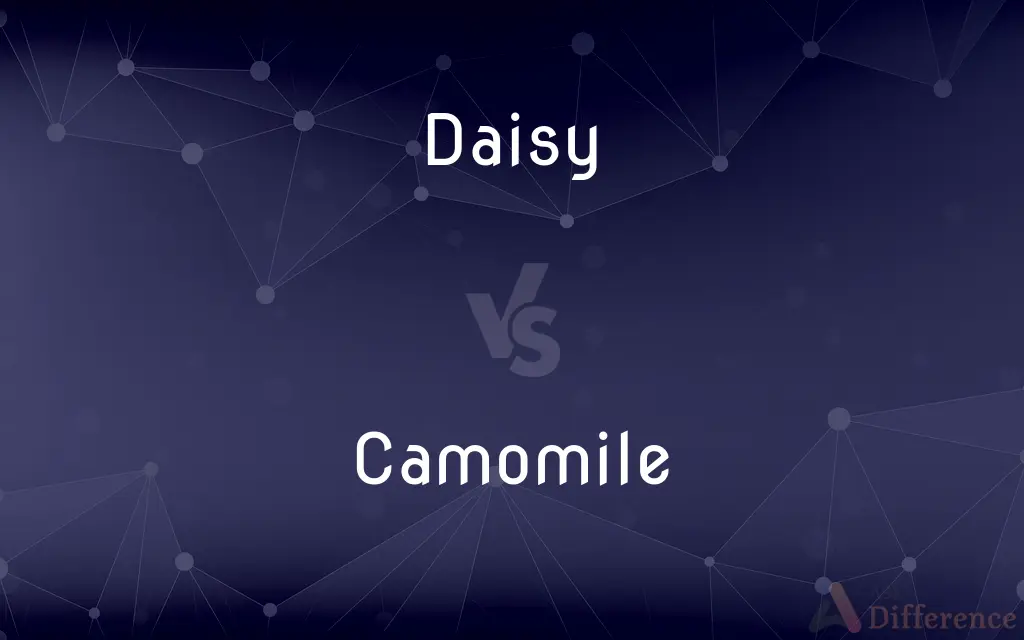Daisy vs. Camomile — What's the Difference?
By Tayyaba Rehman — Updated on September 4, 2023
"Daisy" refers to a family of flowering plants with a central disk and radiating petals, while "Camomile" (often spelled "Chamomile") is a specific daisy-like herb known for its medicinal properties and use in tea.

Difference Between Daisy and Camomile
Table of Contents
ADVERTISEMENT
Key Differences
"Daisy" is a general term that encompasses a wide range of flowering plants belonging to the family Asteraceae. These plants are characterized by their distinctive appearance, with a central disk and radiating petals. This simple yet beautiful flower can be found in various environments, ranging from gardens to wild meadows. Conversely, "Camomile" refers to a specific herb, often associated with the daisy family due to its daisy-like appearance.
While many daisies are grown for ornamental purposes due to their aesthetic appeal, camomile is especially renowned for its medicinal properties. Historically and in modern times, camomile flowers have been used to create herbal remedies and teas. Consuming camomile tea is believed to have various health benefits, including promoting relaxation and aiding in sleep.
In terms of appearance, while both daisies and camomile possess a similar structure with white petals and a yellow center, camomile's petals are more elongated and its center is slightly raised. This distinctive morphology sets camomile apart from other daisy varieties.
Beyond appearance and usage, the term "daisy" can be used more broadly, sometimes colloquially referring to anything that is fresh or innocent. On the other hand, "camomile" predominantly maintains its herbal connotation.
Comparison Chart
Family
Asteraceae
Asteraceae (specifically)
ADVERTISEMENT
Primary Use
Ornamental
Medicinal & Herbal Tea
Appearance
Central disk, radiating petals
Daisy-like with elongated petals and raised center
Connotations
Freshness, innocence
Relaxation, sleep aid
Common Environments
Gardens, wild meadows
Gardens, herbal farms
Compare with Definitions
Daisy
A flowering plant with a central disk and radiating petals.
She picked a daisy from the garden.
Camomile
Often associated with relaxation and sleep.
Drinking camomile helps him sleep soundly.
Daisy
Symbolizing freshness or purity.
Her daisy-like innocence charmed everyone.
Camomile
A daisy-like herb known for its medicinal properties.
She brewed some camomile tea to relax.
Daisy
Member of the Asteraceae family.
The daisy family includes various species.
Camomile
Part of the daisy family with elongated petals.
She noticed the distinct camomile flowers in the meadow.
Daisy
Sometimes used to denote something ordinary or common.
He called it a daisy of an idea, meaning it was simple but effective.
Camomile
A plant used to produce herbal tea.
Camomile tea is her bedtime favorite.
Daisy
A flower often associated with simplicity.
He gave her a bouquet of daisies to brighten her day.
Camomile
Variant of chamomile.
Daisy
A widely naturalized Eurasian plant (Leucanthemum vulgare syn. Chrysanthemum leucanthemum) having flower heads with a yellow center and white rays. Also called oxeye daisy, white daisy.
Camomile
Composite plant with a fragrance reminiscent of apples:
Daisy
A low-growing plant (Bellis perennis) native to Europe and widely naturalized, having flower heads with white or pinkish rays. Also called English daisy.
Camomile
Matricaria recutita (formerly known as Matricaria chamomilla), German chamomile or Hungarian chamomile, with fragrant flowers used for tea, and as an herbal remedy.
Daisy
The flower head of any of these plants.
Camomile
Chamaemelum nobile (formerly Anthemis nobilis), English chamomile or Roman chamomile, a ground cover with fragrant foliage.
Daisy
(Slang) One that is deemed excellent or notable.
Camomile
Any of several other similar plants. (See below)
Daisy
A wild flowering plant Bellis perennis of the Asteraceae family, with a yellow head and white petals
Camomile
A genus of herbs (Anthemis) of the Composite family. The common camomile, Anthemis nobilis, is used as a popular remedy. Its flowers have a strong and fragrant and a bitter, aromatic taste. They are tonic, febrifugal, and in large doses emetic, and the volatile oil is carminative.
Daisy
Many other flowering plants of various species, mostly among the asterids.
Camomile
Eurasian plant apple-scented foliage and white-rayed flowers and feathery leaves used medicinally; in some classification systems placed in genus Anthemis
Daisy
(Cockney rhyming slang) A boot or other footwear.
Camomile
A herb with a slightly apple-like scent.
The camomile's aroma wafted through the garden, reminiscent of apples.
Daisy
A genus of low herbs (Bellis), belonging to the family Compositæ. The common English and classical daisy is Bellis perennis, which has a yellow disk and white or pinkish rays.
Daisy
Any of numerous composite plants having flower heads with well-developed ray flowers usually arranged in a single whorl
Common Curiosities
Can you make tea from Daisies?
While Camomile is specifically used for tea, not all daisies are suitable for consumption.
Is Camomile a type of Daisy?
Yes, Camomile is a specific herb within the daisy family with a daisy-like appearance.
What is a Daisy?
A Daisy is a flowering plant characterized by its central disk and radiating petals.
Why is Camomile popular?
Camomile is renowned for its medicinal properties and use in herbal teas.
What is Daisy primarily used for?
Daisies are often grown for ornamental purposes in gardens.
How do Daisy and Camomile flowers differ in appearance?
Though similar, Camomile has more elongated petals and a slightly raised center.
Are both Daisy and Camomile easy to grow?
Yes, both are relatively easy to cultivate in suitable environments.
What are the health benefits of Camomile?
Camomile is believed to aid relaxation, digestion, and promote sleep.
Is Daisy tea as popular as Camomile tea?
No, Camomile tea is more popular due to its relaxation properties.
Can both Daisy and Camomile grow in the wild?
Yes, both can be found in wild meadows and cultivated gardens.
Are there different species of Daisies?
Yes, there are numerous species within the daisy family.
Which is more commonly used in herbal remedies?
Camomile is more commonly used in herbal remedies compared to general daisies.
Can Daisy have any medicinal properties?
Certain daisy species might have medicinal properties, but Camomile is more renowned for it.
Is Camomile always associated with the daisy family?
Yes, Camomile is a specific herb within the daisy family.
Is the scent of Daisy and Camomile similar?
Camomile has a distinct apple-like aroma, while daisies might not have as strong a scent.
Share Your Discovery

Previous Comparison
Calm vs. Quiet
Next Comparison
Blender vs. GrinderAuthor Spotlight
Written by
Tayyaba RehmanTayyaba Rehman is a distinguished writer, currently serving as a primary contributor to askdifference.com. As a researcher in semantics and etymology, Tayyaba's passion for the complexity of languages and their distinctions has found a perfect home on the platform. Tayyaba delves into the intricacies of language, distinguishing between commonly confused words and phrases, thereby providing clarity for readers worldwide.















































